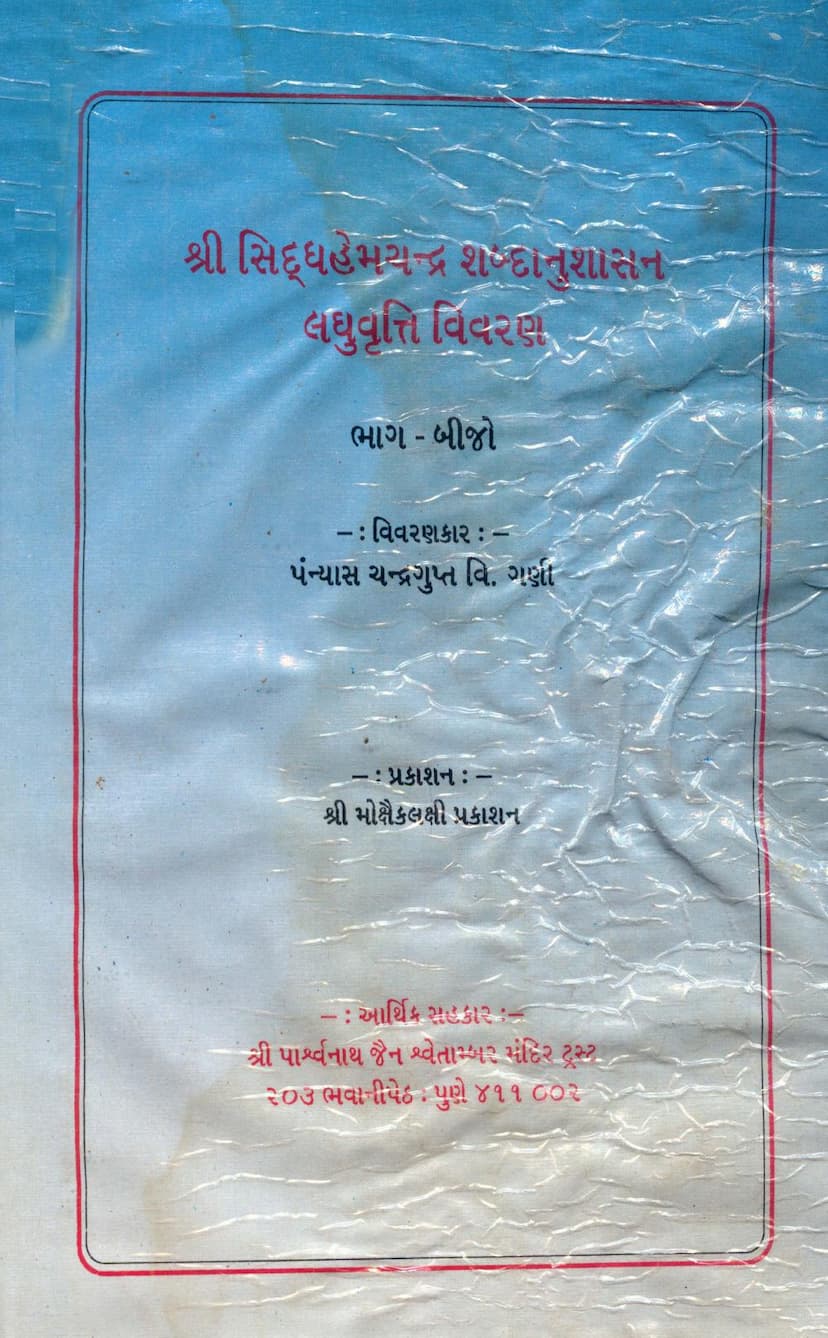Siddhhemchandra Shabdanushasan Laghuvrutti Vivran Part 02
Added to library: September 2, 2025

Summary
The provided text is the second part of the "Siddhhemchandra Shabdanushasan Laghuvrutti Vivran," authored by Chandraguptavijay and published by Mokshaiklakshi Prakashan. This volume is the second part of the commentary on the Siddhhemchandra Shabdanushasan, a foundational grammar text in Jain tradition.
The catalog link points to page 1 of this volume. The text itself appears to be a detailed grammatical analysis, likely explaining sutras (rules) from the original Shabdanushasan. Based on the provided pages, the content focuses on the second chapter (Dvitiya Adhyaya) and its subsequent parts (Padas).
Here's a summary of the key grammatical concepts and discussions covered in the provided pages (Pages 4-139):
Core Grammatical Concepts Discussed:
- Karakas (Agents/Cases): The commentary delves into the concept of 'Karakas,' which are the grammatical agents or cases that indicate the relationship between a verb and other words in a sentence.
- Kriyahetu (Karak as the cause of action): It explains that 'Karak' is defined as the cause of the action (Kriya). The sutra "Kriyahetu Karak" (2|2|1) is discussed, defining the factors contributing to an action.
- Upapad (Upapada): The concept of 'Upapada' is introduced, which refers to a noun that is intrinsically linked to a verb's meaning and influences the case marking.
- Kartu (The Doer/Subject): The text extensively discusses the 'Kartu' (subject) and its definition. It clarifies that the 'Kartu' is the independent agent in the action, whose action is not dependent on other Karakas. The concept of independent will (Vivaksha) is highlighted in determining the 'Kartu'. The sutra "Kartu" (5) is discussed, explaining that the doer of the action is called the 'Kartu'.
- Karma (Object): The commentary explains the 'Karma' (object) and its definition as that which is acted upon by the 'Kartu'. The sutra "Kartuapyana Karma" (2|2|3) is examined, detailing the relationship between the 'Kartu' and the 'Karma'. Different types of 'Karma' are discussed, including 'Nirvyatti' (that which is produced), 'Vikarya' (that which undergoes modification), and 'Praarthya' (that which is sought or attained).
- Dvitikaran (Second Person): The sutra "Vartaman Vartai" is mentioned, implying a discussion on the role of the second person.
- Karmapravachaniiya (Prepositions/Postpositions): The text discusses 'Karmapravachaniiya' and their role in governing case endings. Several sutras (like 2|2|4 onwards) deal with specific verbs and their grammatical implications, particularly when verbs are used in causative or other forms.
- Causative Verbs (Lyagarthak): The text extensively discusses the grammatical rules related to causative verbs (when one person causes another to perform an action). It explains how the subject of the original verb becomes the object in the causative construction. Sutras like "Va Karmmanamalikartau Nau" (2|2|4), "Gatyarthabodhajararthashabda-karmakannityakarma" (2|2|5), and "Hru-Kro-anva" (2|2|8) are examined, detailing the transformation of subjects and objects in causative sentences.
- Dhatus (Verbs): The commentary analyzes various 'Dhatus' (verb roots) and their grammatical behavior, especially in relation to Karakas and case endings. For example, verbs related to movement (Gatyarthaka), knowledge (Bodharthaka), eating (Ahararthaka), and those that are inherently transitive or intransitive are discussed.
Key Themes and Explanations:
- Nirvacana (Etymology/Derivation): The commentary often explains the derivation of words and grammatical terms, adhering to the Vyakaraṇa tradition of analyzing the meaning and form of words.
- Anvitartha (Meaningful Connection): It emphasizes the importance of 'Anvitartha' (meaningful connection) and 'Vyupttyartha' (derived meaning) in understanding grammatical rules, distinguishing between words whose meaning is directly derived from their root and those whose meaning is established by convention.
- Vivaksha (Intention of the Speaker): The author frequently highlights the role of 'Vivaksha' (the speaker's intention) in determining the grammatical case or function of a word. This is crucial in Sanskrit and Prakrit grammar, as the same noun might take different case endings depending on the intended emphasis.
- Apavada (Exception to a Rule): The commentary often explains how specific rules ('Apavada') override general rules ('Utsarga').
- Niyam (Rule/Regulation): The text meticulously explains specific rules and their exceptions, aiming to provide a comprehensive understanding of the grammatical system.
- Examples from Scripture and Usage: The commentary often illustrates its points with examples from Jain scriptures or classical Sanskrit literature, demonstrating the application of the rules.
Structure and Presentation:
- The text follows the traditional structure of grammatical commentaries, quoting sutras and then providing detailed explanations, examples, and discussions on their nuances.
- The author, Chandraguptavijay, is identified as a disciple in the lineage of Acharya Shri Muktichandrasuriji Maharaja, indicating a strong adherence to established Jain scholastic traditions.
- The publication is supported by the Shri Parshvanath Jain Shwetambar Mandir Trust, Pune, suggesting its distribution and availability within the Jain community.
In essence, the provided text is a scholarly and technical commentary on Jain grammar, meticulously explaining complex rules of Sanskrit grammar as applied within the Jain tradition. It focuses on the relationships between verbs and nouns (Karakas), the formation of words, and the subtle intentions of the speaker in shaping grammatical expression.